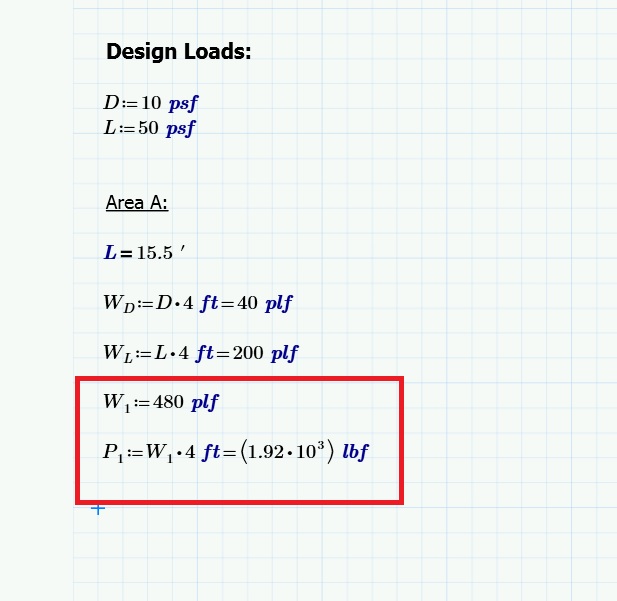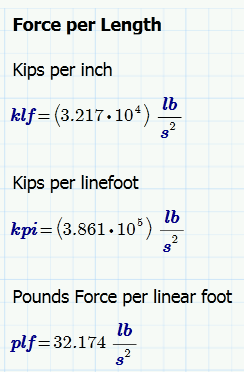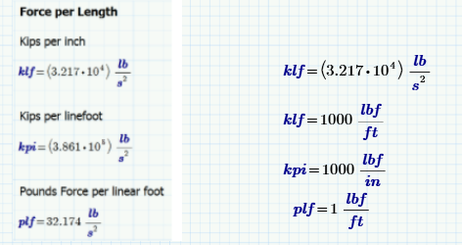Community Tip - Did you know you can set a signature that will be added to all your posts? Set it here! X
- Subscribe to RSS Feed
- Mark Topic as New
- Mark Topic as Read
- Float this Topic for Current User
- Bookmark
- Subscribe
- Mute
- Printer Friendly Page
MathCAD Units Help
- Mark as New
- Bookmark
- Subscribe
- Mute
- Subscribe to RSS Feed
- Permalink
- Notify Moderator
MathCAD Units Help
I am using MathCAD Prime 2.0 for design calculations for a building I am engineering. I am fairly new to MathCAD, only learning a little about it in college. However, I am running into a units issue when calculating pounds per linear foot (lb/ft) to just pounds (a point load). I am taking 480 PLF * 4 ft, the feet should cancel out and you are left with just pounds. MathCAD is spitting out a lb*f, like the units for a moment. When I go to change the units to just pounds then it changes my units to (ft/s^2)*lb? Please explain to me what is going wrong here. See below for a screen shot:
Please note that the answer is correct, 1920 pounds is the right answer. Just the wrong units.
Thank you in advance,
Jon Recknagel | Structural Designer
Solved! Go to Solution.
- Labels:
-
Other
Accepted Solutions
- Mark as New
- Bookmark
- Subscribe
- Mute
- Subscribe to RSS Feed
- Permalink
- Notify Moderator
I just answered my own question. A "lbf"= a pound force. It seems like they could have just left it at "lb" we are all aware that pounds is a force. Just my opinon I guess. Thanks anyway.
- Mark as New
- Bookmark
- Subscribe
- Mute
- Subscribe to RSS Feed
- Permalink
- Notify Moderator
I just answered my own question. A "lbf"= a pound force. It seems like they could have just left it at "lb" we are all aware that pounds is a force. Just my opinon I guess. Thanks anyway.
- Mark as New
- Bookmark
- Subscribe
- Mute
- Subscribe to RSS Feed
- Permalink
- Notify Moderator
It seems like they could have just left it at "lb" we are all aware that pounds is a force.
The pound is a unit of mass, not force.
- Mark as New
- Bookmark
- Subscribe
- Mute
- Subscribe to RSS Feed
- Permalink
- Notify Moderator
I would disagree....Pounds (lb) is not a mass. Pounds is a force. F=mg, due to gravity.
- Mark as New
- Bookmark
- Subscribe
- Mute
- Subscribe to RSS Feed
- Permalink
- Notify Moderator
What unit are you using for m?
- Mark as New
- Bookmark
- Subscribe
- Mute
- Subscribe to RSS Feed
- Permalink
- Notify Moderator
m=F/G, most engineering firms (in the US anyway) do not work in terms of metric units of mass. Everything is in pounds, a force. When you step on the scale at home you do not read your weight in terms of mass, you read your weight it terms of pounds, due to gravity, which is a force.
- Mark as New
- Bookmark
- Subscribe
- Mute
- Subscribe to RSS Feed
- Permalink
- Notify Moderator
It's not a question of metric vs non-metric. I asked because the only unit systems in which pounds are a force are the gravitational systems, in which the base units are force, length, and time, rather than mass length and time. If the base unit of force is the pound, then the mass unit is the slug, and is defined in terms of the pound. The slug is defined as a mass that accelerates by 1 ft/s2 when a force of one pound is applied.
All unit systems in Mathcad are based on mass, length and time though. It does not have unit systems based on either force, length and time as the base units, or weight, length, time as the base units. In Mathcad a pound is always a mass. A pound force is distinguished from that by using the nomenclature lbf.
What a bathroom scale says is irrelevant. Most people don't even know the distinction between mass and weight. You can get scales that read kg too, and there is no unit system in which kg is a unit of anything other than mass.
- Mark as New
- Bookmark
- Subscribe
- Mute
- Subscribe to RSS Feed
- Permalink
- Notify Moderator
"lbf" is a unit of force.
In the English unit the correct mass is a slug but no body uses the unit.
- Mark as New
- Bookmark
- Subscribe
- Mute
- Subscribe to RSS Feed
- Permalink
- Notify Moderator
You are absolutely correct!
lbf is pound force. lb (or lbm) is mass, so is slug.
- Mark as New
- Bookmark
- Subscribe
- Mute
- Subscribe to RSS Feed
- Permalink
- Notify Moderator
- Mark as New
- Bookmark
- Subscribe
- Mute
- Subscribe to RSS Feed
- Permalink
- Notify Moderator
I thought there was something wrong here!
- Mark as New
- Bookmark
- Subscribe
- Mute
- Subscribe to RSS Feed
- Permalink
- Notify Moderator
- Mark as New
- Bookmark
- Subscribe
- Mute
- Subscribe to RSS Feed
- Permalink
- Notify Moderator
Okay, attached (in Prime 4 Express) is a start through the paper Piping-System Solutions Using Mathcad, B.K, Hodge and Robert P. Taylor, May 1, 2002.
By doing a unit balance of equation (1), we can correct the equation and demonstrate that the conversion factor is NOT required.
- Mark as New
- Bookmark
- Subscribe
- Mute
- Subscribe to RSS Feed
- Permalink
- Notify Moderator
Dear Fred, could you attach also a pdf? Thank you so much. Filip
- Mark as New
- Bookmark
- Subscribe
- Mute
- Subscribe to RSS Feed
- Permalink
- Notify Moderator
- Mark as New
- Bookmark
- Subscribe
- Mute
- Subscribe to RSS Feed
- Permalink
- Notify Moderator
- Mark as New
- Bookmark
- Subscribe
- Mute
- Subscribe to RSS Feed
- Permalink
- Notify Moderator
You clearly have a system that works for you; enjoy it and good luck.
I spent (roughly) twenty years doing this type of calculation (and others) in Mathcad and wrestling with units. Much of that effort was spent taking expressions like equation (1) and making sure the units balanced properly; That's what I was attempting here. "all unit conversions are essentially multiplication by 1. They are never necessary but always helpful." One of Mathcad's features that has saved me numerous times is the automatic unit conversions. If I expect an calculation to result in a moment (ft lbf) and the answer Mathcad labels J, I can simply replace Mathcad's units with mine:


With that in mind I propose a new pressure unit
- Mark as New
- Bookmark
- Subscribe
- Mute
- Subscribe to RSS Feed
- Permalink
- Notify Moderator
The "lbf", pounds force is there to differentiate between pounds mass, which is just "lb". Something which matters greatly when doing dynamics, rather than statics.
- Mark as New
- Bookmark
- Subscribe
- Mute
- Subscribe to RSS Feed
- Permalink
- Notify Moderator
You may want to check how the different units for Force per Length are defined in Mathcad

Maybe this thread is helpful http://communities.ptc.com/message/30166#30166
- Mark as New
- Bookmark
- Subscribe
- Mute
- Subscribe to RSS Feed
- Permalink
- Notify Moderator
Careful!
You've run afoul of Mathcad's rule to use only the units required. The definitions are valid if you proscribe the units
- Mark as New
- Bookmark
- Subscribe
- Mute
- Subscribe to RSS Feed
- Permalink
- Notify Moderator







